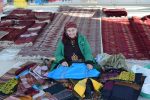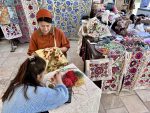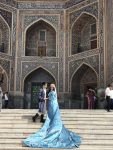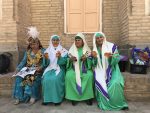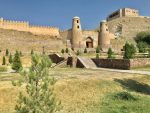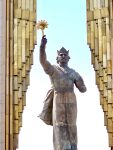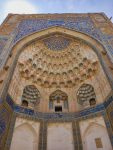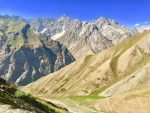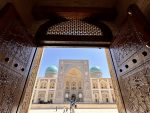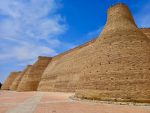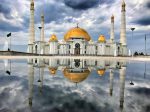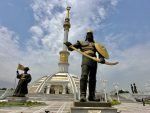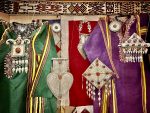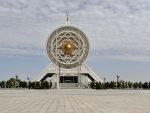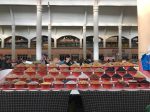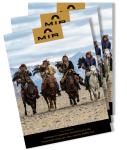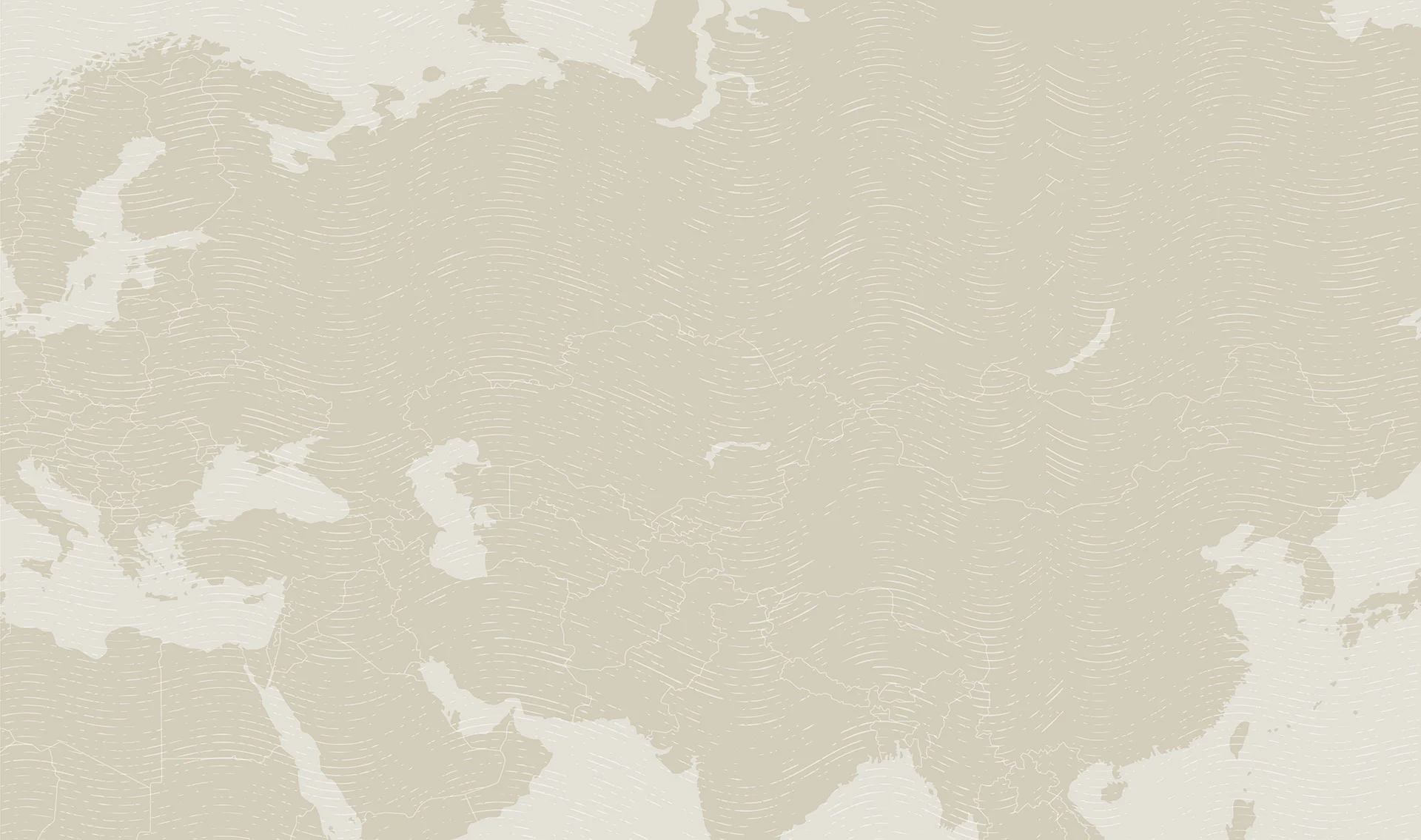Silk Road Backroads & Byways
Photo credit: Abdu Samadov
Deserts & Diversions in Tajikistan, Uzbekistan & Turkmenistan
Overview
This tour emphasizes the wide range of experiences you can have in the fascinating countries of Tajikistan, Uzbekistan, and Turkmenistan, and is the ideal choice for a first or repeat visit to Central Asia. You’ll visit the rightfully famous Silk Road oasis cities of Samarkand and Bukhara; but you’ll also head off the tourist path to discover the capital of Tajikistan, Dushanbe, Termez, Uzbekistan, once a stronghold of Buddhism, a strikingly gorgeous limestone canyon, and a lively Caspian Sea port. Accommodations range from an opulent seaside resort to a yurt camp at the cusp of a glowing gas crater. If you’re looking for new, authentic, unforgettable adventures, you’ll be well served by this Silk Road trip.
Note that with this itinerary, travelers already familiar with the classic sights of Samarkand and Bukhara can opt to skip them in favor of more off-the-beaten-path exploring.
Travels to: Tajikistan, Turkmenistan, Uzbekistan

Map

Itinerary
-
Days 1-3: Dushanbe (Tajikistan)

Start your journey by taking in the sights Tajikistan’s capital, Dushanbe, including a stroll through Rudaki Park, visits to both the modern National Museum of Tajikistan and the small but fascinating Gurminj Museum of Musical Instruments featuring exhibits from Afghanistan, the Pamirs, Turkiye, and China. Trace the footsteps of Silk Road traders outside of town to the 18th-century Hisor Fortress, once a great center of commerce and learning.
HIGHLIGHTS
- The covered Mehrgon Bazaar, which carries on Dushanbe’s traditional role as a market town
- Exuberant demonstrations frequently performed at the Gurminj Museum of Musical Instruments
- The imposing towers of Hisor Fortress
-
Days 4-5: Termez (Uzbekistan), Sayrob, Baysun, Shahrisabz

Cross the border into Uzbekistan to explore Termez, once a stronghold of Buddhism before Islam arrived here. Travel overland through Sayrob and Baysun villages, known for their handicrafts. In Shahrisabz, admire Ak-Sarai Palace, an architectural masterpiece, and one of Tamerlane’s most expansive undertakings.
HIGHLIGHTS
- The 11th and 12th century Sultan-Saodat complex
- The 16th-century Kokildor-Ota Khanaka, the final resting place of a local Sufi saint.
- Ruins of Kyrk Kyz fortified castle for the local Samanid rulers during the 9th and 19th centuries.
- Zurmala Stupa, the largest Buddhist stupa in the region, and possibly the oldest.
- Baysun village, one of the oldest inhabited places in Central Asia; UNESCO inscribed to the Representative List of the Intangible Cultural Heritage of Humanity.
- Shahrisabz, the birthplace of Tamerlane, and the ruins of Ak Sarai (White Palace), built in the 14th century and one of Tamerlane’s most ambitious projects.
-
Days 6-7: Samarkand

Continue to the legendary Silk Road oasis of Samarkand. Admire UNESCO-listed Registan Square, Ulug Bek’s medieval observatory, and learn about Central Asian carpets or hike in a neighboring village.
HIGHLIGHTS
- Samarkand’s Registan Square, bordered by three beautiful madrassahs
- The 14th-century conqueror Tamerlane’s architectural legacy in Samarkand, including Bibi Khanum Mosque – the largest of its day – and Ulug Bek Observatory
- Tour the gardens outside the silk carpet factory where the weavers grow indigo, coleus, and dahlias to use for dye.
- Take an optional hike through sheep herder trails to a nearby village, and visit with a local family.
-
Days: 8-9: Bukhara

Continue along the Silk Road to the next desert oasis city of Bukhara. Learn about the art of embroidered suzani-making at a cooperative workshop. Stroll Labi-Hauz Place and explore the Ark Citadel, the original fortress of Bukhara. Enjoy a concert of traditional folk music at a madrassah.
HIGHLIGHTS
- Old Bukhara’s ageless domed bazaars and its central Lyab-i-Hauz Plaza, adorned with a reflecting pool
- Ark Citadel – Bukhara’s huge, ancient fortress
- Visit a village where a coop workshop offers a place for women to embroider the brilliant cloth coverlets called suzani
-
Days: 10-13: Turkmenabad (Turkmenistan), Ashgabat, Darvaza

We continue tracing the Silk Road crossing over the Amu Darya River, once known as the Oxus, overland across the Turkmenistan border to Turkmenabad. That evening, fly to Ashgabat, the Turkmen capital known for its monumental white marble buildings. Drive through the Kara Kum Desert to a yurt camp in the desert near the burning Darvaza Gas Crater, one of Turkmenistan’s most unusual sights, nicknamed “the Door to Hell.” Return to Ashgabat.
HIGHLIGHTS
- Cross through Turkmenabat, Turkmenistan’s second-largest city with unfortunately no traces of its 2,000-year-old history
- The opulent new architecture of Ashgabat, which holds a Guinness record for highest density of white marble buildings in the world
- Yurt camping near the Darvaza Gas Crater as it glows in the dark
-
Day 14: Ashgabat, Nohur, Balkanabat

Travel overland from Ashgabat out toward the coast. Journey out into the desert and up into the Kopet Dag Mountains to visit the isolated Nohur people, whose longstanding cultural traditions have felt little influence from the outside world.
HIGHLIGHTS
- Panoramic views in the Kopet Dag Mountains
- A visit to a silk-weaving workshop in a Nohur tribal village
-
Days 15-18: Yangykala, Turkmenbashi, Ashgabat

Dedicate a day to scenic, picturesque Yangykala Canyon, where striated limestone cliffs unfold before you in a strange, strikingly beautiful high desert panorama. Then for something completely different, head to Turkmenistan’s only seaport – Turkmenbashi – and Awaza, a neighboring resort town studded with five-star hotels. Take a cruise along the Caspian coast and explore a local bazaar. The next day a one-hour flight gets you to Ashgabat, hopefully in time to visit a local market. Reminisce about your adventures that evening at a farewell dinner.
HIGHLIGHTS
- Unusual, and unusually photogenic, Yangykala Canyon
- A yacht cruise along the Caspian Sea coast
- Shopping at Turkmenbashi bazaar – a good place to find deals on Caspian caviar
- A final farewell in Ashgabat
Dates & Prices
Small group tour – max 16 travelers
Land tour price, per person. Based on double occupancy and minimum group size of 6 travelers.
-
2026 Dates
Aug 29 - Sept 15Tour, double occupancy$7,095Plus internal airfare$250Single supplement$1,050
What's Included
-
Tour Includes
- Accommodations, as noted in the itinerary.
- Most meals, as noted in the itinerary:18 breakfasts, 17 lunches and 14 dinners.
- Bottled water at group meals.
- Restaurant tips for included meals.
- Services of experienced, English-speaking local guides, drivers and other staff and a MIR Tour Manager throughout the land tour.
- Arrival/departure airport transfers. MIR will arrange for all travelers to be met on arrival and seen off on departure whether we make your airfare arrangements or not, provided you arrive and depart on the tour start/end dates in the tour start/end cities.
- Ground transportation throughout itinerary by private coach or van (size of vehicle depends on group size).
- Guided sightseeing tours and entrance fees as outlined in itinerary.
- Special events, excursions and cultural performances per the itinerary.
- Baggage handling where available.
- Gratuities to local guides, drivers, porters and other service personnel.
- Complete pre-departure electronic document that includes detailed packing suggestions, reading list links, country-specific information, maps, travel tips and more.
- Customized visa application and instruction kit (please note, visa fees are not included in the tour price).
- Electronic final update bulletin, with any late news, updates and important information.
-
Not Included
- Internal airfare (quoted separately and is subject to change by airlines).
- International airfare or taxes/fuel surcharges.
- Meals not specified as included in the itinerary.
- Single supplement charge, if requested or required.
- Items of a personal nature (phone calls, email, laundry, alcohol, excess baggage, etc).
- Gratuities to Tour Manager.
- Visa/passport fees, airport departure fees.
- Expenses incurred as a result of delay, modification or extension of a tour due to causes beyond MIR’s control.
- Travel entry pass to Turkmenistan payable on arrival, currently $12-$15, subject to change.
- Travel and trip cancellation insurance.
Activity Level
-
Level 4: Rigorous
Level 4: Rigorous
This small group tour features long days walking and standing while touring, some long segments of overland travel, foot traverses of several border points while carrying/rolling luggage, some rustic accommodations, some uneven surfaces and steps, absent handrails, some stair-climbing, and absence of elevators. Only those fit to travel and who are willing to accept local standards of amenities and services, and the physical challenges, should consider joining this program.
Travelers must be able to walk at least two miles a day, keeping up with fellow travelers. Border crossings may require walking ¼ to ½ mile while managing luggage; and bags may need to be carried rather than rolled, as the road/sidewalk surface is not always paved or smooth. The rustic accommodations mentioned above include a very moderate guesthouse for one night in Turkmenistan and a desert tent camp for one night. The first is spent in a homestay/guesthouse where sleeping accommodations are shared with other group members in a large A/C indoor room or an oversize outdoor veranda, sleeping on mattresses placed on the floor; there are rustic outdoor WCs and an outdoor bucket shower. One night is spent yurt or tent camping at Darvaza in the desert in a temporary camp. Western style trekking tents with sleeping bags, mats, and pillows are provided. Expect rustic outhouse facilities with no running water. There is no electricity to charge phones or camera batteries, though there is a generator which provides lighting for the toilets and shower. If you rely on electricity for CPAP, or for any other reason, you must have your own battery or other back-up, or please reconsider participation.
There are overall shortcomings in the tourism infrastructure of these developing destinations, including some that can cause walking challenges such as unpaved sidewalks, uneven surfaces and steps, packed-dirt streets, broken pavement (streets or sidewalks), and a general absence of handrails or ramps. Some attractions are only accessible via steep staircases with tall uneven steps – these additionally may be spiral staircases and/or in narrow passages with limited light. Elevators are not available at touring sites, nor at a few of the hotels.
Past travelers have also encountered challenges with plumbing, bureaucratic service, variety of locally available foods, and availability and quality of public restrooms.






